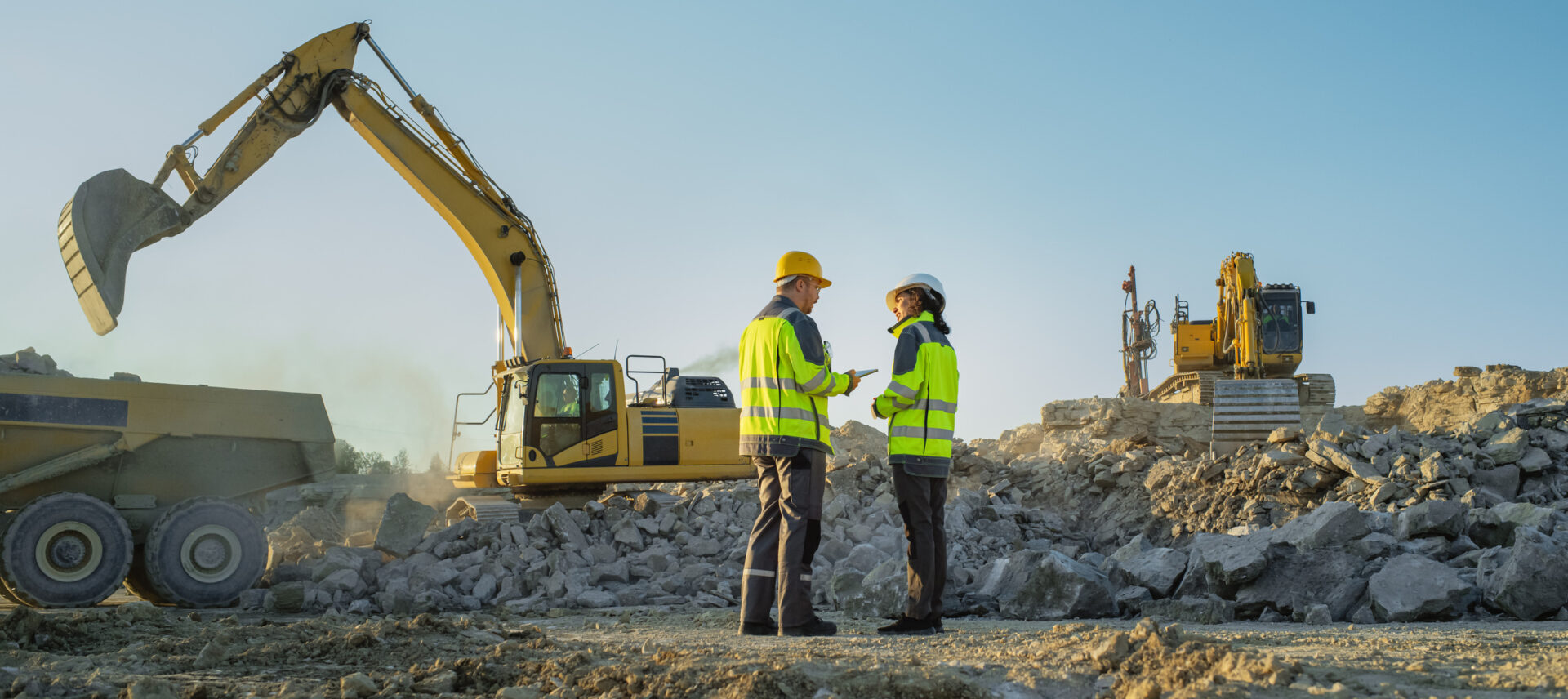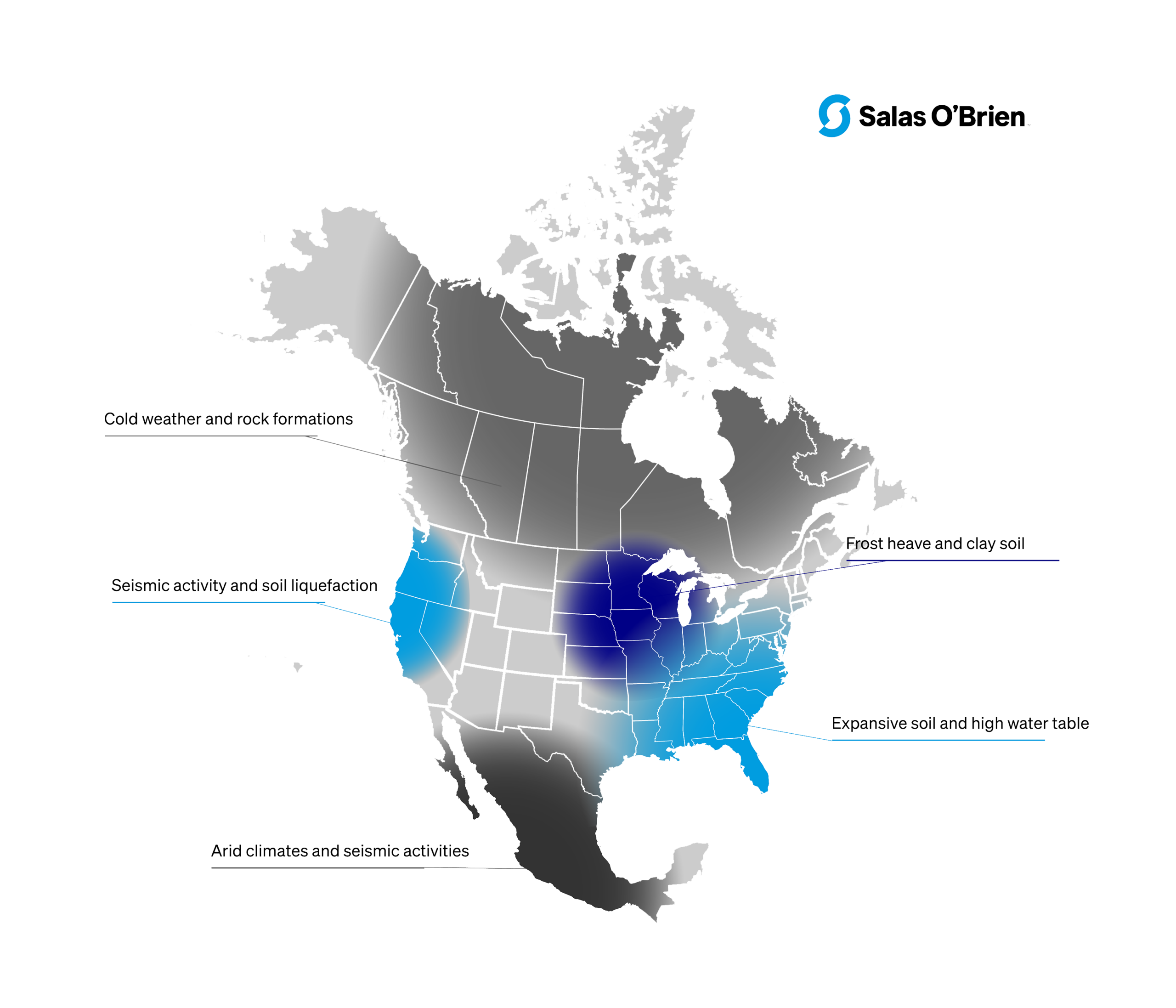News & Insights
The need for hyperlocal foundation design
Geographical factors shape the engineering and construction practices of foundations across North America. From seismic activity on the West Coast to frost heave challenges in the Midwest, this article highlights the need for a hyperlocal focus on geotechnical to ensure sturdy structures in different regions.

Foundations are the structural elements that transfer the loads from the building to the ground, and they are essential for the stability and performance of any structure. Foundations are also one of the most complex and challenging aspects of structural engineering, as they require the integration of geotechnical, structural, and construction disciplines.
One of the most critical factors in selecting a foundation design approach is the geotechnical conditions, which can vary significantly not only by region but also within the same area. This variability necessitates a hyperlocal approach to foundation design, ensuring that the specific needs of the building are meticulously tailored to its exact location.
Geotechnical understanding must be hyperlocal
The foundation design process begins with obtaining a geotechnical report, which outlines soil and groundwater conditions and offers recommendations on the appropriate type and size of the foundation. This report is the result of thorough site investigations and laboratory tests performed by geotechnical engineers to determine soil and rock properties and behaviors. They assess factors like bearing capacity, settlement, and lateral resistance to provide design parameters.
Structural engineers depend on these reports to choose and design suitable foundation systems for buildings. Depending on site conditions and building loads, the foundation system may be shallow or deep, incorporating elements like footings, piles, caissons, grade beams, mats, or slabs. It’s essential that the foundation supports the building safely, preventing excessive settlement or lateral movement, and that all elements withstand applied loads without surpassing their strength or serviceability limits.
Local construction preferences and practices matter
Beyond the technical aspects of a geotechnical report, local construction preferences and practices significantly influence foundation design. These preferences vary widely across regions and even between cities, shaped by factors such as material and equipment availability, labor skills, environmental regulations, and cultural traditions.
Having a deep understanding of these local nuances is important. For instance, a structural engineer who has spent their career in Texas might notice discrepancies in projects engineered by firms from other regions that are unfamiliar with local risk factors and construction practices. This lack of local insight can lead to foundation distress and structural damage.
By integrating knowledge of local construction preferences with the technical requirements from geotechnical reports, engineers can design foundations that not only meet safety and durability standards but also align with local building practices. This approach also helps ensure the construction process runs smoothly, minimizing the risk of delays, disputes, and errors.
Classifications of foundations
Distinct geographical conditions necessitate the use of various foundation types, each tailored to meet unique environmental challenges. Foundations are generally divided into two primary categories: shallow and deep. Here are some of the most common applications:
Shallow foundations
Shallow foundations require the ground to be stable with minimal soil improvement needed. Here are some of the methodologies:
- Strip foundations: Primarily used for load-bearing walls, strip foundations distribute the weight of a structure over linear strips. They are best suited for soils with good bearing capacity and are relatively cost effective.
- Pad foundations: These are isolated footings used to support individual columns. They are commonly used where the soil has moderate to high bearing capacity. The Geotechnical engineer must provide a bearing depth for pad and strip foundations to ensure stability and performance.
- Mat foundations: Also known as raft foundations, these are used when soil conditions are relatively poor and the load needs to be distributed over a larger area to avoid soil failure. Mat foundations typically encompass the entire footprint of the building, require multiple layers of rebar, and require large concrete pours.
Deep foundations
Deep foundations are typically required for large building loads or when there is weak surface soil, variable soil, expansive soil, or a high water table. Deep foundation methodologies include:
- Pile foundations: These extend deep into the ground to transfer the structural load to a more stable soil layer. Pile foundations are often used in areas with weak topsoil or for structures that carry heavy loads. Piles achieve design capacity through skin friction and end bearing depending on the existing soils. Pile foundations can consist of either driven or augured piles. Driven piles are typically either timber or precast concrete piles. Augured piles, also referred to as continuous flight auger piles, involve a process of drilling a hollow stem auger to the required depth and injecting pumped grout as the auger is withdrawn. Advantages of augured piles are limited vibration, ability to penetrate deep into the existing soils and high capacities. Under heavy concentrated loads, piles are clustered together underneath a pile cap which evenly distributes the loads to each pile.
- Drilled shafts: Similar to pile foundations, but generally larger in diameter, drilled shafts are often used for large structures. They offer a high load-carrying capacity and are ideal for transferring loads through water or weak soils into deeper rock strata. Drilled shafts gain their compressive strength through end bearing and skin friction .
- Helical piles (also known as screw piles): These consist of a steel shaft with one or more helical plates attached to it. The plates allow the pile to be screwed into the ground to minimize soil displacement. They’re often used in retrofits because they can be installed in tight footprints and projects with low ceiling clearance. The voids between the plates may be filled with flowable grout during installation to achieve a greater design strength.
- Micropiles: These small (typically less than 12 inches in diameter) piles are drilled and grouted into place. Because of their small size, micropiles are particularly useful in restricted or confined spaces where larger machinery cannot be accommodated. Micropiles are popular in regions with rocky soil conditions since the drilling methods can penetrate through difficult terrains.
- Caissons: These are watertight retaining structures used when the work is carried out under the water level. Often employed in the construction of bridges and docks, caissons provide a stable foundation by resisting buoyancy and lateral loads.
Each type of foundation comes with its own set of benefits and limitations, making the choice heavily dependent on structural and geographical considerations. With this in mind, let’s explore the challenges faced in different geographical regions.

Local geotechnical factors that influence foundation design
Local geotechnical characteristics play a pivotal role in what is needed to design foundations that are not only structurally sound but also contextually appropriate. Here are some common factors:
Frost Heave
In areas subjected to severe cold, the foundation and structure must account for frost heave, a phenomenon that occurs when moisture in the soil freezes and expands. This can exert upward pressure on the foundation, leading to structural instability. To combat this, structural engineers often employ frost-protected shallow foundations (FPSF), which incorporate insulation to manage the heat transfer between the building and the surrounding soil, thereby mitigating the effects of frost heave. The Geotechnical engineer will typically provide a minimum embedment of the footings below grade for protection against frost heave.
Frost depth can vary dramatically by region. For example, in the US, Kansas may have 30 inches of frost, but in northern Minnesota it can be ~5 foot deep. Engineers in these areas often use frost-protected shallow foundations or incorporate other anti-frost measures, such as ground insulation, to prevent upward force on the foundation during freeze-thaw cycles.
Rock formations
In cases where the rock layer is near the surface, shallow foundations can be directly anchored into the rock, providing an extremely stable base. Alternatively, techniques such as rock anchors or tiedowns can be used to secure the foundation to the rock formations below, ensuring a high level of stability.
In areas where excavation into rock is needed, the use of explosives or hydraulic breakers may become necessary. This not only increases the complexity but also the cost and timeframe of the construction project.
Seismic activity
Foundations in seismically active areas are often designed to withstand not just vertical loads but also lateral and rotational movements caused by earthquakes. The use of deep foundations, particularly pile foundations and drilled shafts, provides additional stability by transferring the building’s load to deeper, more stable soil strata or even to bedrock.
Innovative approaches like base isolation techniques are increasingly being used in seismically active regions. Base isolation involves placing a structure on bearings, springs, or other devices that can absorb seismic energy, thereby isolating the building from the ground motion during an earthquake.
One of the most significant risks during an earthquake is soil liquefaction, a phenomenon where saturated or partially saturated soil loses its strength and stiffness. This can lead to foundation failure, highlighting the importance of detailed soil investigations. Engineers may choose to employ ground improvement techniques, such as soil stabilization or vibro-compaction, to mitigate the risks.
Expansive clay soils
Clay-rich soils tend to expand when the moisture content increases and shrink when the moisture content decreases. These volumetric fluctuations can result in differential foundation movement, causing stress and potential damage to the building. Engineers often opt for deep foundations like drilled shafts or employ ground improvement methods such as moisture conditioning to improve soil properties and mitigate risks.
Given the expansive nature of clay soils, site drainage and landscaping can have significant long-term effects on the foundation performance.
Arid conditions and soil
Arid climates lead to soil characteristics that can be problematic for foundation engineering. Dry soil tends to have lower cohesion, which can lead to issues like settlement and cracking. Techniques such as soil stabilization using lime or cement can help improve soil characteristics and make it more suitable for construction.
Agricultural impact
Agricultural activity can influence soil properties over time. Chemical fertilizers and irrigation practices may alter soil composition, requiring potential adaptation of foundation designs.
High water tables
In areas with high water tables, shallow foundations are often unsuitable due to the risk of buoyancy and instability. Engineers typically resort to deep foundations, such as piles or caissons, to bypass the waterlogged upper soil layers and anchor the structure into deeper, more stable strata. For properties near the coastline, additional considerations such as saltwater corrosion and wind loads from tropical storms or hurricanes come into play. Specialized materials like corrosion-resistant steel or concrete additives can be used to enhance the durability of the foundation.
Coastal and river line areas susceptible to scour and erosion that can undermine the integrity of a foundation may require methods like riprap, matting, or even driven piles to protect against soil erosion.
With a hyperlocal approach to these factors, engineers can create more effective and sustainable foundation solutions to enhance the durability and functionality of structures.
How Salas O’Brien can help with foundation design
Foundation design is nuanced. Relying solely on the limited information in a geotechnical report will not necessarily provide a design that meets the specific criteria of the site. Understanding traditional foundation requirements can serve as a valuable cost-saving tool for projects. Salas O’Brien has a strong footprint in North America with experienced structural engineers in all geographic regions.
Relying on specialists that have deep expertise in your region who can provide a hyperlocal focus ensures designs that not only meet the challenges of the area but can also produce a set of drawings that local contractors will understand and be able to build from.
Want to talk about your specific project? Reach out to one of our contributors below.
For media inquiries on this article, reach out to Stacy Lake, Director of Corporate Communications.

Scott Armstrong, PE
Scott Armstrong is an innovator in challenging, cost-effective structural design solutions. With an outstanding reputation in the architectural and construction communities, Scott is known for reliably strong performance and developing long-term relationships with clients. Scott serves as a Principal with Salas O’Brien. Contact him at [email protected]

Brad Carville, PE
Brad Carville leads the New Orleans office for Salas O’Brien, delivering structural engineering services to a diverse range of clients in the Gulf Coast area. He collaborates closely with local Salas O’Brien MEP teams and other disciplines to offer comprehensive engineering solutions. Brad graduated from Louisiana State University with a bachelor’s degree in civil engineering with a focus on structures. He serves as an Associate Vice President and structural engineer at Salas O’Brien. Contact him at [email protected]